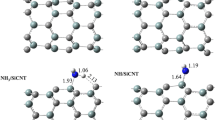Summary
In conclusion, let us again ask ourselves the question formulated at the beginning of our paper; why does transfer of reaction from the gas phase to the surface of a semiconductor result in facilitation of the reaction? Answering this question is equivalent to answering the question of what the mechanism of the action of a semiconductor is.
Investigation of the mechanism of chemisorption throws some light on this question. As we have seen, saturated molecules in passing into the chemisorbed state are converted into surface radicals. This in itself chemisorbed state are converted into surface radicals. This in itself increases their reactivity, for radicals are always more reactive than saturated molecules. Hence, the adsorption act itself, with which every heterogeneous catalytic process begins, results in increase in the reactivity of the molecules taking part in the process.
In what then is the specific role of the catalyst?
The transformation of molecules into surface radicals occurs, as we have seen, by the use of free valences of the surface itself. These surface valences therefore play the main part in the direction of the process. The catalyst is the carrier of such free valences. As we have seen, the functions of these free valences are performed by free electrons and holes in the crystal lattice.
Hence, the crystal, taken as a whole, may be regarded as a sort of macroscopic molecule having unsaturated valences; it can be regarded as a sort of “polyradical”. The part played by free radicals in the kinetics of homogeneous reactions is well known. The introduction of such radicals into a medium in which reaction is occurring (i.e., the introduction of free valences) causes increase in reaction rate. In the case of catalysis, free valences are introduced by the catalyst itself. The introduction of these free valences stimulates the reaction. We arrive at the concept of the crystalline catalyst as a peculiar kind of “polyradical”. We must therefore abandon the long-held view of the existence of a difference in principle between heterogeneous catalysis and the kinetics of homogeneous reactions.
Similar content being viewed by others
Literature cited
F. F. Volkenshtein, Bull. Acad. Sci. USSR, Div. Chem. Sci. 1953, 788, 972.
F. F. Volkenshtein, J. Phys. Chem. 27, 159 (1953); 27, 167 (1953).
F. F. Volkenshtein, in the Collection “Problems of Kinetics and Catalysis,” Vol. 8, Izd. AN SSSR, 1955, p. 79.
F. F. Volkenshtein and V. B. Sandomirsky, loc. cit., 8, 1955, p. 189.
V. V. Voevodsky, F. F. Volkenshtein, and N. N. Semenov, in the Collection “Questions of Chemical Kinetics, Catalysis, and Reactivity,” Izd. AN SSSR, 1955, p. 423.
F. F. Volkenshtein, Bull. Acad. Sci. USSR, Div. Chem. Sci. 1957, 143.
Slater, Phys. Rev. 38, 1109 (1931).
Author information
Authors and Affiliations
Additional information
Paper read at International Congress on Catalysis at Philadelphia, US, September 1956
Rights and permissions
About this article
Cite this article
Volkenshtein, F.F. Mechanism of the catalytic action of semiconductors. Russ Chem Bull 6, 955–959 (1957). https://doi.org/10.1007/BF01173590
Received:
Issue Date:
DOI: https://doi.org/10.1007/BF01173590




